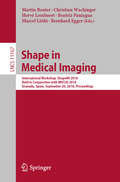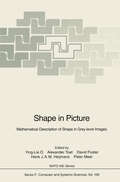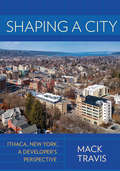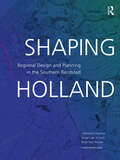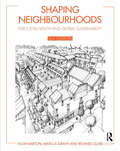- Table View
- List View
Shape as Memory: A Geometric Theory of Architecture (The Information Technology Revolution in Architecture)
by Michael LeytonHow do buildings store information and experience in their shape and form? Michael Leyton has attracted considerable attention with his interpretation of geometrical form as a medium for the storage of information and memory. In this publication he draws specific conclusions for the field of architecture and construction, attaching fundamental importance to the complex relationship between symmetry and asymmetry.
Shape, Contour and Grouping in Computer Vision (Lecture Notes in Computer Science #1681)
by David A. Forsyth Joseph L. Mundy Vito Di Gesu Roberto CipollaComputer vision has been successful in several important applications recently. Vision techniques can now be used to build very good models of buildings from pictures quickly and easily, to overlay operation planning data on a neuros- geon’s view of a patient, and to recognise some of the gestures a user makes to a computer. Object recognition remains a very di cult problem, however. The key questions to understand in recognition seem to be: (1) how objects should be represented and (2) how to manage the line of reasoning that stretches from image data to object identity. An important part of the process of recognition { perhaps, almost all of it { involves assembling bits of image information into helpful groups. There is a wide variety of possible criteria by which these groups could be established { a set of edge points that has a symmetry could be one useful group; others might be a collection of pixels shaded in a particular way, or a set of pixels with coherent colour or texture. Discussing this process of grouping requires a detailed understanding of the relationship between what is seen in the image and what is actually out there in the world.
Shape Detection in Computer Vision Using the Hough Transform
by V.F. LeaversShape detection techniques are an important aspect of computer vision and are used to transform raw image data into the symbolic representations needed for object recognition and location. However, the availability and application of research data relating to shape detection has traditionally been limited by a lack of computational and mathematical skill on the part of the intended end-user. As a result progress in areas such as the automation of visual inspection techniques, where shape detection couls play a pivotal role, has been relatively slow. In this volume, Violet Leavers, an established author and researcher in the field, examines the Hough Transform, a technique which is particularly relevant to industrial applications. By making computational recipes and advice available to the non-specialist, the book aims to popularize the technique, and to provide a bridge between low level computer vision tasks and specialist applications. In addition, Shape Detection in Computer Vision Using the Hough Transform assesses practical and theoretical issues which were previously only available in scientific literature in a way which is easily accessible to the non-specialist user. Shape Detection in Computer Vision Using the Hough Transform fills an obvious gap in the existing market. It is an important textbook which will provide postgraduate students with a thorough grounding in the field, and will also be of interest to junior research staff and program designers.
Shape in Medical Imaging: International Workshop, Shapemi 2018, Held In Conjunction With Miccai 2018, Granada, Spain, September 20, 2018, Proceedings (Lecture Notes in Computer Science #11167)
by Bernhard Egger Marcel Lüthi Beatriz Paniagua Hervé Lombaert Christian Wachinger Martin ReuterThis book constitutes the proceedings of the Workshop on Shape in Medical Imaging, ShapeMI 2018, held in conjunction with the 21st International Conference on Medical Image Computing, MICCAI 2018, in Granada, Spain, in September 2018. The 26 full papers and 2 short papers presented were carefully reviewed and selected for inclusion in this volume. The papers discuss novel approaches and applications in shape and geometry processing and their use in research and clinical studies and explore novel, cutting-edge theoretical methods and their usefulness for medical applications, e.g., from the fields of geometric learning or spectral shape analysis.
Shape in Medical Imaging: International Workshop, ShapeMI 2023, Held in Conjunction with MICCAI 2023, Vancouver, BC, Canada, October 8, 2023, Proceedings (Lecture Notes in Computer Science #14350)
by Christian Wachinger Beatriz Paniagua Shireen Elhabian Jianning Li Jan EggerThis volume comprises the proceedings of the International Workshop, ShapeMI 2023, which took place alongside MICCAI 2023 on October 8, 2023, in Vancouver, British Columbia, Canada.The 23 selected full papers deal with all aspects of leading methods and applications for advanced shape analysis and geometric learning in medical imaging.
Shape in Picture: Mathematical Description of Shape in Grey-level Images (NATO ASI Subseries F: #126)
by Ying-Lie O Alexander Toet David Foster Henk J. A M. Heijmans Peter MeerThe fields of image analysis, computer vision, and artificial intelligence all make use of descriptions of shape in grey-level images. Most existing algorithms for the automatic recognition and classification of particular shapes have been devel oped for specific purposes, with the result that these methods are often restricted in their application. The use of advanced and theoretically well-founded math ematical methods should lead to the construction of robust shape descriptors having more general application. Shape description can be regarded as a meeting point of vision research, mathematics, computing science, and the application fields of image analy sis, computer vision, and artificial intelligence. The NATO Advanced Research Workshop "Shape in Picture" was organised with a twofold objective: first, it should provide all participants with an overview of relevant developments in these different disciplines; second, it should stimulate researchers to exchange original results and ideas across the boundaries of these disciplines. This book comprises a widely drawn selection of papers presented at the workshop, and many contributions have been revised to reflect further progress in the field. The focus of this collection is on mathematical approaches to the construction of shape descriptions from grey-level images. The book is divided into five parts, each devoted to a different discipline. Each part contains papers that have tutorial sections; these are intended to assist the reader in becoming acquainted with the variety of approaches to the problem.
Shape Memory Alloys in Civil Engineering (The Materials Research Society Series)
by Bassem AndrawesThis book presents a new class of metallic materials, called shape memory alloys (SMAs), as emerging materials for civil engineering applications. These materials have been used for decades in high-end fields like the aerospace and biomedical fields, and possess extraordinary properties that have attracted the attention of civil engineering researchers and practitioners for over 25 years. In this volume, based on 20 years of research findings, the author describes how SMAs started to find their way into practical applications in civil engineering. And that, like any metal, SMAs are produced in any shape, size, or form including wire, bar, and sheet, but unlike other metals, SMAs exhibit a unique ability to recover their original shape/size after being excessively deformed. Given the demand for sustainability and resilience in civil engineering applications, this book is ideal for civil engineering practitioners and materials researchers concerned with building materials and civil infrastructure.
The Shape of a Pocket (Vintage International Series)
by John BergerJohn Berger writes: 'The pocket in question is a small pocket of resistance. A pocket is formed when two or more people come together in agreement. The resistance is against the inhumanity of the new world economic order. The people coming together are the reader, me and those the essays are about - Rembrandt, Palaeolithic cave painters, a Romanian peasant, ancient Egyptians, an expert in the loneliness of certain hotel bedrooms, dogs at dusk, a man in a radio station. And unexpectedly, our exchanges strengthen each of us in our conviction that what is happening to the world today is wrong, and that what is often said about it is a lie. I've never written a book with a greater sense of urgency.'
The Shape of Content (The\charles Eliot Norton Lectures #19)
by Ben ShahnIn his 1956–57 Charles Eliot Norton Lectures, the Russian-born American painter Ben Shahn sets down his personal views of the relationship of the artist—painter, writer, composer—to his material, his craft, and his society. He talks of the creation of the work of art, the importance of the community, the problem of communication, and the critical theories governing the artist and his audience.
The Shape of Motion: Cinema and the Aesthetics of Movement
by Jordan SchonigIn The Shape of Motion: Cinema and the Aesthetics of Movement, author Jordan Schonig provides a new way of theorizing cinematic motion by examining cinema's "motion forms": structures, patterns, or shapes of movement unique to the moving image. From the wild and unpredictable motion of flickering leaves and swirling dust that captivated early spectators, to the pulsing abstractions that emerge from rapid lateral tracking shots, to the bleeding pixel-formations caused by the glitches of digital video compression, each motion form opens up the aesthetics of movement to film theoretical inquiry. By pairing close analyses of onscreen movement in narrative and experimental films with concepts from Maurice Merleau-Ponty, Henri Bergson, and Immanuel Kant, Schonig rethinks longstanding assumptions within film studies, such as indexical accounts of photographic images and analogies between the camera and the human eye. Arguing against the intuition that cinema reproduces our natural perception of motion, The Shape of Motion shows how cinema's motion forms do not merely transpose the movements of the world in front of the camera, they transform them.
The Shape of Motion: Cinema and the Aesthetics of Movement
by Jordan SchonigIn The Shape of Motion: Cinema and the Aesthetics of Movement, author Jordan Schonig provides a new way of theorizing cinematic motion by examining cinema's "motion forms": structures, patterns, or shapes of movement unique to the moving image. From the wild and unpredictable motion of flickering leaves and swirling dust that captivated early spectators, to the pulsing abstractions that emerge from rapid lateral tracking shots, to the bleeding pixel-formations caused by the glitches of digital video compression, each motion form opens up the aesthetics of movement to film theoretical inquiry. By pairing close analyses of onscreen movement in narrative and experimental films with concepts from Maurice Merleau-Ponty, Henri Bergson, and Immanuel Kant, Schonig rethinks longstanding assumptions within film studies, such as indexical accounts of photographic images and analogies between the camera and the human eye. Arguing against the intuition that cinema reproduces our natural perception of motion, The Shape of Motion shows how cinema's motion forms do not merely transpose the movements of the world in front of the camera, they transform them.
Shape Perception in Human and Computer Vision: An Interdisciplinary Perspective (Advances in Computer Vision and Pattern Recognition)
by Sven J. Dickinson and Zygmunt PizloThis comprehensive and authoritative text/reference presents a unique, multidisciplinary perspective on Shape Perception in Human and Computer Vision. Rather than focusing purely on the state of the art, the book provides viewpoints from world-class researchers reflecting broadly on the issues that have shaped the field. Drawing upon many years of experience, each contributor discusses the trends followed and the progress made, in addition to identifying the major challenges that still lie ahead. Topics and features: examines each topic from a range of viewpoints, rather than promoting a specific paradigm; discusses topics on contours, shape hierarchies, shape grammars, shape priors, and 3D shape inference; reviews issues relating to surfaces, invariants, parts, multiple views, learning, simplicity, shape constancy and shape illusions; addresses concepts from the historically separate disciplines of computer vision and human vision using the same “language” and methods.
Shape Reconstruction from Apparent Contours: Theory and Algorithms (Computational Imaging and Vision #44)
by Giovanni Bellettini Valentina Beorchia Maurizio Paolini Franco PasquarelliMotivated by a variational model concerning the depth of the objects in a picture and the problem of hidden and illusory contours, this book investigates one of the central problems of computer vision: the topological and algorithmic reconstruction of a smooth three dimensional scene starting from the visible part of an apparent contour.The authors focus their attention on the manipulation of apparent contours using a finite set of elementary moves, which correspond to diffeomorphic deformations of three dimensional scenes.A large part of the book is devoted to the algorithmic part, with implementations, experiments, and computed examples. The book is intended also as a user's guide to the software code appcontour, written for the manipulation of apparent contours and their invariants. This book is addressed to theoretical and applied scientists working in the field of mathematical models of image segmentation.
Shaped By War
by Don McCullinNo other photographer in modern times has recorded war and its aftermath as widely and unsparingly as Don McCullin. After a childhood in London during the Blitz, and after the hardships of evacuation, McCullin feels his life has indeed been shaped by war.From the building of the Berlin Wall at the height of the Cold War to El Salvador and Kurdistan, McCullin has covered the major conflicts of the last fifty years, with the notable exception of the Falklands, for which he was denied access. His pictures from the Citadel in Hue and in the ruins of Beirut are among the most unflinching records of modern war. The publication of many of his greatest stories in the Sunday Times magazine did much to raise the consciousness of a generation, even if he himself now fears that photographs cannot prevent history from repeating itself. The brutality of conflict returns over and over again. McCullin here voices his despair.McCullin recounts the course of his professional life in a series of devastating texts on war, the events and the power of photography. The conclusion of the book marks McCullin’s retreat to the Somerset landscape surrounding his home, where the dark skies over England remind him yet again of images of war. Despite the sense of belonging and even contentment, for him there is no final escape.
Shaping a City: Ithaca, New York, a Developer's Perspective
by Mack TravisPicture your downtown vacant, boarded up, while the malls surrounding your city are thriving. What would you do?In 1974 the politicians, merchants, community leaders, and business and property owners, of Ithaca, New York, joined together to transform main street into a pedestrian mall. Cornell University began an Industrial Research Park to keep and attract jobs. Developers began renovating run-down housing. City Planners crafted a long-range plan utilizing State legislation permitting a Business Improvement District (BID), with taxing authority to raise up to 20 percent of the City tax rate focused on downtown redevelopment.Shaping a City is the behind-the-scenes story of one developer’s involvement, from first buying and renovating small houses, gradually expanding his thinking and projects to include a recognition of the interdependence of the entire city—jobs, infrastructure, retail, housing, industry, taxation, banking and City Planning. It is the story of how he, along with other local developers transformed a quiet, economically challenged upstate New York town into one that is recognized nationally as among the best small cities in the country.The lessons and principles of personal relationships, cooperation and collaboration, the importance of density, and the power of a Business Improvement District to catalyze change, are ones you can take home for the development and revitalization of your city.
Shaping Femininity: Foundation Garments, the Body and Women in Early Modern England
by Sarah BendallIn sixteenth and seventeenth-century England, the female silhouette underwent a dramatic change. This very structured form, created using garments called bodies and farthingales, existed in various extremes in Western Europe and beyond, in the form of stays, corsets, hoop petticoats and crinolines, right up until the twentieth century. With a nuanced approach that incorporates a stunning array of visual and written sources and drawing on transdisciplinary methodologies, Shaping Femininity explores the relationship between material culture and femininity by examining the lives of a wide range of women, from queens to courtiers, farmer's wives and servants, uncovering their lost voices and experiences. It reorients discussions about female foundation garments in English and wider European history, arguing that these objects of material culture began to shape and define changing notions of the feminine bodily ideal, social status, sexuality and modesty in the early modern period, influencing enduring Western notions of femininity.Beautifully illustrated in full colour throughout, Shaping Femininity is the first large-scale exploration of the materiality, production, consumption and meanings of women's foundation garments in sixteenth and seventeenth-century England. It offers a fascinating insight into dress and fashion in the early modern period, and offers much of value to all those interested in the history of early modern women and gender, material culture and consumption, and the history of the body, as well as curators and reconstructors.
Shaping Femininity: Foundation Garments, the Body and Women in Early Modern England
by Sarah BendallIn sixteenth and seventeenth-century England, the female silhouette underwent a dramatic change. This very structured form, created using garments called bodies and farthingales, existed in various extremes in Western Europe and beyond, in the form of stays, corsets, hoop petticoats and crinolines, right up until the twentieth century. With a nuanced approach that incorporates a stunning array of visual and written sources and drawing on transdisciplinary methodologies, Shaping Femininity explores the relationship between material culture and femininity by examining the lives of a wide range of women, from queens to courtiers, farmer's wives and servants, uncovering their lost voices and experiences. It reorients discussions about female foundation garments in English and wider European history, arguing that these objects of material culture began to shape and define changing notions of the feminine bodily ideal, social status, sexuality and modesty in the early modern period, influencing enduring Western notions of femininity.Beautifully illustrated in full colour throughout, Shaping Femininity is the first large-scale exploration of the materiality, production, consumption and meanings of women's foundation garments in sixteenth and seventeenth-century England. It offers a fascinating insight into dress and fashion in the early modern period, and offers much of value to all those interested in the history of early modern women and gender, material culture and consumption, and the history of the body, as well as curators and reconstructors.
Shaping Holland: Regional Design and Planning in the Southern Randstad
by Jeroen van Schaick Francisco Colombo Peter WitsenAll around the world, regions are facing major challenges: climate change, the transition to renewable energy, reinventing the food system, ongoing urbanisation and finding room to sustain biodiversity. These will radically transform our living and working environments. Regional design uses the power of visualisation to unite regional players around appealing spatial development visions for meeting those challenges. It offers a route to new forms of regional governance and planning that match the urgencies of our time. This book exposes the benefits and the pitfalls of regional plans and designs. Shaping Holland gives a unique insight into the emergence of contemporary regional planning and design practice in the Netherlands. This densely populated country in the delta of the Rhine and Meuse rivers is internationally renowned for its urban planning and design tradition. Drawing on first-hand accounts and a rich collection of illustrations, maps and diagrams, the book gives pointers for practitioners, academics and students of spatial planning, urban design and landscape architecture. Regional design is on the rise in all continents. It provides an answer to a world in which economic activities, activity patterns, urban growth and ecological systems are no respecters of administrative boundaries. Amid the growing number of academic analyses of regional design, this book is unique because it focuses on planning practice and first-hand knowledge. As such it is of interest to a broad international readership.
Shaping Holland: Regional Design and Planning in the Southern Randstad
by Jeroen van Schaick Francisco Colombo Peter WitsenAll around the world, regions are facing major challenges: climate change, the transition to renewable energy, reinventing the food system, ongoing urbanisation and finding room to sustain biodiversity. These will radically transform our living and working environments. Regional design uses the power of visualisation to unite regional players around appealing spatial development visions for meeting those challenges. It offers a route to new forms of regional governance and planning that match the urgencies of our time. This book exposes the benefits and the pitfalls of regional plans and designs. Shaping Holland gives a unique insight into the emergence of contemporary regional planning and design practice in the Netherlands. This densely populated country in the delta of the Rhine and Meuse rivers is internationally renowned for its urban planning and design tradition. Drawing on first-hand accounts and a rich collection of illustrations, maps and diagrams, the book gives pointers for practitioners, academics and students of spatial planning, urban design and landscape architecture. Regional design is on the rise in all continents. It provides an answer to a world in which economic activities, activity patterns, urban growth and ecological systems are no respecters of administrative boundaries. Amid the growing number of academic analyses of regional design, this book is unique because it focuses on planning practice and first-hand knowledge. As such it is of interest to a broad international readership.
Shaping Interior Space: - with STUDIO
by Roberto J. RengelShaping Interior Space, 4th Edition, emphasizes the experiential contributions of interior design. Intended for all design students, the author covers strategies for creating interior environments that work as a total system to enhance the experience of the user. The book is organized into three parts, a background part introduces ways of designing for experience and reviews design principles and strategies. Part Two focuses on the three experiential goals that form the backbone of the book, order, enrichment, and expression. These serve as overall umbrellas that capture the many dimensions of users' experiences in the built environment. Part Three is devoted to design process. The process is broken up into understanding, ideation, and development and covers many tasks performed during the early and intermediate stages of design.PLEASE NOTE: Purchasing or renting this ISBN does not include access to the STUDIO resources that accompany this text. To receive free access to the STUDIO content with new copies of this book, please refer to the book + STUDIO access card bundle ISBN 9781501326707.
Shaping Jerusalem: Spatial planning, politics and the conflict
by Francesco ChiodelliShaping Jerusalem: Spatial planning, politics and the conflict focuses on a hidden facet of the Israeli-Palestinian conflict; the relentless reshaping of the Holy City by the Israeli authorities through urban policies, spatial plans, infrastructural and architectural projects, land use and building regulations. From a political point of view, the Israeli-Palestinian conflict may appear to be at an impasse; however, it is precisely by looking at the city’s physical space that one can perceive that a war of cement and stone is under way. Many books have been written on the Israeli-Palestinian conflict over Jerusalem; some of them have focused on the urban fabric; Shaping Jerusalem uniquely discusses the role of Israeli spatial actions within the conflict. It argues that Israel’s main political objective – control over the whole city – is ordinarily and silently pursued through physical devices which permanently modify the territory and the urban fabric. Relying on strong empirical evidence and data through the analysis of statistical data, official policies, urban projects, and laws, author Francesco Chiodelli substantiates the political discussion with facts and figures about the current territorial situation of the city, and about the Israeli policies implemented in the city in the past six decades.
Shaping Jerusalem: Spatial planning, politics and the conflict
by Francesco ChiodelliShaping Jerusalem: Spatial planning, politics and the conflict focuses on a hidden facet of the Israeli-Palestinian conflict; the relentless reshaping of the Holy City by the Israeli authorities through urban policies, spatial plans, infrastructural and architectural projects, land use and building regulations. From a political point of view, the Israeli-Palestinian conflict may appear to be at an impasse; however, it is precisely by looking at the city’s physical space that one can perceive that a war of cement and stone is under way. Many books have been written on the Israeli-Palestinian conflict over Jerusalem; some of them have focused on the urban fabric; Shaping Jerusalem uniquely discusses the role of Israeli spatial actions within the conflict. It argues that Israel’s main political objective – control over the whole city – is ordinarily and silently pursued through physical devices which permanently modify the territory and the urban fabric. Relying on strong empirical evidence and data through the analysis of statistical data, official policies, urban projects, and laws, author Francesco Chiodelli substantiates the political discussion with facts and figures about the current territorial situation of the city, and about the Israeli policies implemented in the city in the past six decades.
Shaping Light for Video in the Age of LEDs: A Practical Guide to the Art and Craft of Lighting
by Alan SteinheimerA practical, hands-on guide to lighting for video, this book explores how LEDs are changing the aesthetics of lighting and provides students with an indispensable guide to the everyday techniques required to produce professional-quality lighting in the age of LEDs and wireless control options. The book focuses on first-hand application of technical knowledge, beginning with simple lighting setups and progressing to more complicated scenarios, and features accompanying diagrams, illustrations and case studies to demonstrate their real-world application. Key topics covered include basic three-point lighting, lighting moving actors, set lighting and exposure, instrument selection, bringing style to your lighting, color temperature and the Kelvin scale, exterior lighting, lighting categories and genres, green-screen techniques, money and budgeting, and electricity and electrical distribution. The book also provides guidance on career paths including what a grip does, case studies with photos and diagrams, and an extensive glossary of set terminology to introduce students to the language of filmmaking. A must-have resource for film and media production students taking classes in lighting and/or cinematography.
Shaping Light for Video in the Age of LEDs: A Practical Guide to the Art and Craft of Lighting
by Alan SteinheimerA practical, hands-on guide to lighting for video, this book explores how LEDs are changing the aesthetics of lighting and provides students with an indispensable guide to the everyday techniques required to produce professional-quality lighting in the age of LEDs and wireless control options. The book focuses on first-hand application of technical knowledge, beginning with simple lighting setups and progressing to more complicated scenarios, and features accompanying diagrams, illustrations and case studies to demonstrate their real-world application. Key topics covered include basic three-point lighting, lighting moving actors, set lighting and exposure, instrument selection, bringing style to your lighting, color temperature and the Kelvin scale, exterior lighting, lighting categories and genres, green-screen techniques, money and budgeting, and electricity and electrical distribution. The book also provides guidance on career paths including what a grip does, case studies with photos and diagrams, and an extensive glossary of set terminology to introduce students to the language of filmmaking. A must-have resource for film and media production students taking classes in lighting and/or cinematography.
Shaping Neighbourhoods: For Local Health and Global Sustainability
by Hugh Barton Marcus Grant Richard GuiseThis substantially revised and important second edition comes at a pivotal time, with both a strong agenda of localism in planning and with public health professionals now realising the vital importance of shaping urban environments in order to reduce the burden of disease and support better health outcomes. This guide ensures you: understand the underlying principles for planning healthy and sustainable neighbourhoods and towns plan the collaborative and inclusive processes needed for multi-sectoral cooperation develop know-how and skills in matching local need with urban form discover new ways to integrate development with natural systems design places with character and recognise good urban form guide communities, and advise developers, in the creation of successful and sustainable places for living. Containing many new case studies and a wealth of new research, this new edition has benefited from previous user feedback. Shaping Neighbourhoods is the indispensable guide for bridging the gulf between theory and practice, between planning authorities, investors and communities, and between different professional perspectives. Whether you are a student faced with a local planning project; a planner, urban designer or developer involved in new development; a health authority concerned with promoting physical activity; or a community group wanting to improve your neighbourhood; this book is for you.



